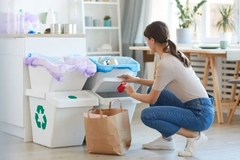Researchers uncap influence of plastic colorants in microplastic formation

16 May 2024 --- Researchers from the University of Leicester in the UK and the University of Cape Town in South Africa have revealed a link between vibrant plastic colors, such as red, blue and green, and accelerated microplastic formation. The findings show how the choice of colorants in plastic formulation can impact degradation rates and subsequent environmental damage.
The researchers used two complementary studies to ascertain that plastics of the same composition degrade at different rates depending on what is added to color them.
“A static experimental exposure of differently colored PP bottle tops from the same manufacturer to a moderate climate over three years showed that black, white and silver plastics were almost unaffected, whereas the blue, green and especially red pigments used in this study were significantly degraded,” write the study authors.
“The second part of the study collected littered high-density PE (HDPE) plastic containers from a remote South African beach and analyzed their condition as a function of the given manufacturing date stamp. Most items were black or white, and samples up to 45 years old were found to have relatively little environmental degradation other than mild abrasion.”
“Carbon and titanium dioxide colorants appear to protect the HDPE polymer from photolytic degradation. Anthraquinone, phthalocyanine and diketopyrrolopyrrole pigments were found to enable UV light to degrade the polymer, leading to brittle plastics and promoting the formation of microplastics. It is likely that other pigments that do not strongly absorb UV will result in similar degradation.” Degradation observed by researchers in colored versus plain plastic caps (Image credit: Key et al).
Degradation observed by researchers in colored versus plain plastic caps (Image credit: Key et al).
Plain vs. bright colorants
The research published in the Environmental Pollution journal was led by Dr. Sarah Key.
Key conducted the studies while a PhD student at the University of Leicester School of Chemistry and was funded by CENTA — The Central England NERC Training Alliance. She is now a senior research analyst with the climate action NGO Waste & Resources Action Programme (WRAP).
“It’s amazing that samples left to weather on a rooftop in Leicester, UK, and those collected on a windswept beach at the southern tip of the African continent show similar results,” Key comments.
“The experiments showed that even in a relatively cool and cloudy environment for only three years, huge differences can be seen in the formation of microplastics. Colorful plastics, such as red and green, degrade and form microplastics quickly. Plainer colors, such as black and white, are quite stable and remain intact.”
“Next time you clean up some plastic litter, take note of the color and think about how soon it would have otherwise broken down. Whatever the color, always check the packaging for details on how to recycle plastic packaging,” she says.
 The study authors urge manufacturers to rethink their approach to plastic design and packaging color for short-lived plastics.Rethinking material design
The study authors urge manufacturers to rethink their approach to plastic design and packaging color for short-lived plastics.Rethinking material design
According to the authors, the study’s implications extend beyond scientific curiosity, urging manufacturers to rethink their approach to plastic design and packaging color for short-lived plastics.
Key asserts that “manufacturers should consider both the recyclability of the material and the likelihood of it being littered when designing plastic items and packaging.”
“For items used outdoors or extensively exposed to sunlight, such as plastic outdoor furniture, consider avoiding colors like red, green and blue to make them last as long as possible. Where the plastic is designed to break down, such as by using pro-oxidant additives, consider the role that color could play in this.”
The study’s co-author, professor Sarah Gabbott, from the University of Leicester School of Geography Geology and the Environment, underscored the impact of their research on environmental conservation efforts.
“I’ve often wondered why microplastics in beach sand often appear to be all the rainbow colors. Until our study, I assumed that my eyes were being deceived and that I just saw the more colorful microplastics because they were easier to spot,” she notes.
“Turns out there are likely to be more brightly colored microplastics in the environment because those plastic items pigmented red, green and blue are more susceptible to being fragmented into millions of tiny yet colorful microplastic particles.”
By Radhika Sikaria











